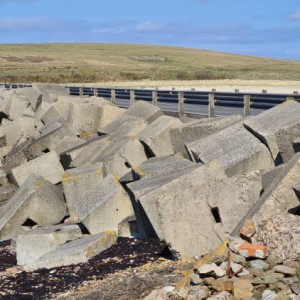Third Barrier
This is view along the third Barrier. The old timber boxes in the foreground are the old shuttering boxes used to make the concrete blocks.
Today the blockships of Scapa Flow offer great shallow wreck diving. The remains of some vessels can still be seen jutting above the water while crossing the Churchill Barriers which link the mainland of Orkney to Lamb Holm, Glimps Holm, Burray and South Ronaldsay.
During World War I strong defences were put in place throughout Scapa Flow to protect the British ships against attack. Anti-submarine netting was suspended across some of the larger channels into the Flow. Blockships were deliberately sunk in the smaller channels to further prevent the possibility of the Germans gaining access into Scapa Flow.
By the dawn of World War II these defences had fallen into disrepair. They were soon proved severely inadequate when HMS Royal Oak was sunk at anchor on 14 October 1939. Shortly before midnight on 13 October, the German submarine U-47 crept undetected into Scapa Flow through Kirk Sound. Although the shallow eastern passages were believed to be secure, U-47 was still able to navigate around the obstructions at high tide. A total of 834 men were killed when the U-boat's torpedoes struck HMS Royal Oak, causing her to sink at frightening speed.
In response to the attack, First Lord of the Admiralty Winston Churchill ordered the construction of several permanent barriers to prevent any further attacks.
Huge concrete blocks were assembled across the channels, replacing the unreliable blockships with more permanent and impenetrable barriers. Work began in May 1940 but was not completed until September 1944. The barriers were officially opened on 12 May 1945, four days after the end of World War II in Europe.
These concrete causeways are now known as the Churchill Barriers. They provide road access from the mainland to Burray and South Ronaldsay.
The Skerry and East Weddell Sound blockships can still be seen jutting above the water as you cross the barriers. These blockships now offer great shallow wreck dives. The wrecks in East Weddell Sound are often used as training sites – allowing divers to refine their skills before visiting the deeper wrecks of the German High Seas Fleet in the heart of Scapa Flow.
From Scapa Flow Historic Wreck Site
https://www.scapaflowwrecks.com/wrecks/blockships/


Comments New comments are not currently accepted on this journal.